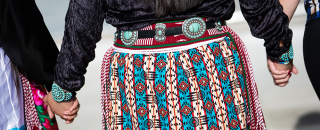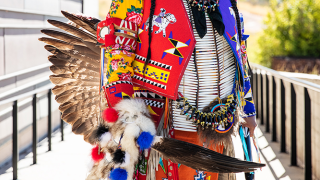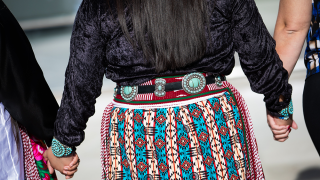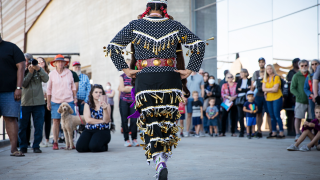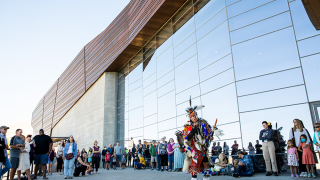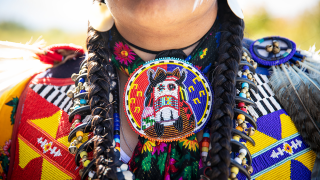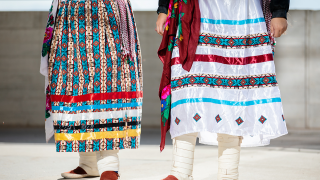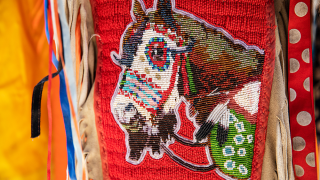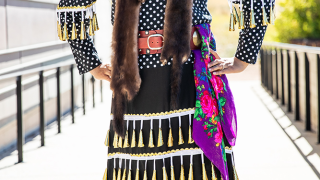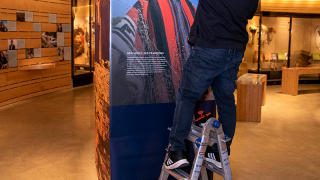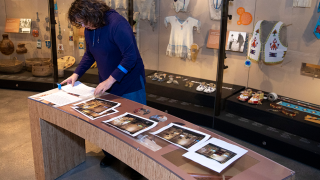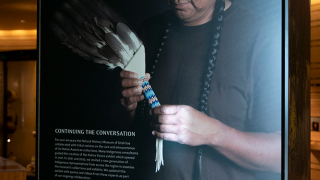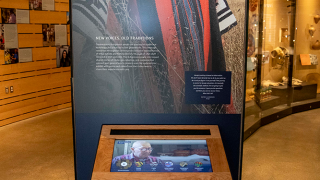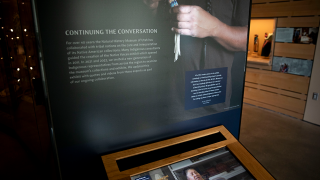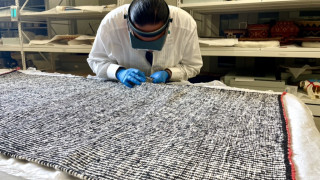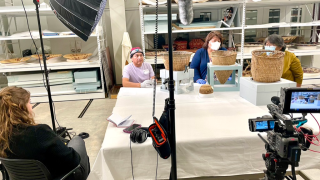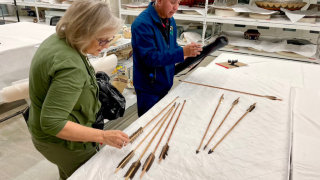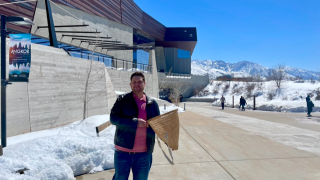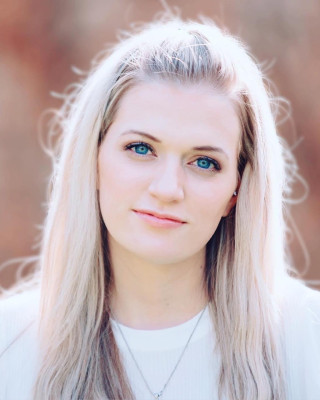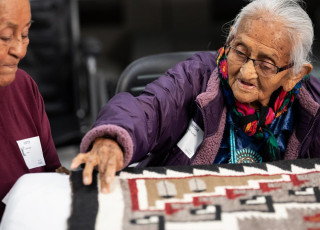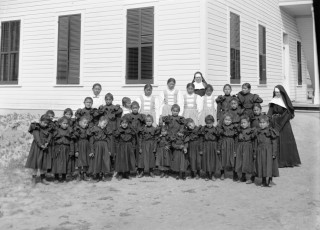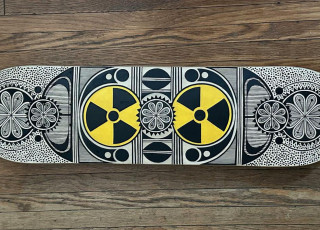Utah’s Indigenous Communities Lead the Way: The Native Voices Initiative
By Olivia Barney
The Natural History Museum of Utah seeks to honor, support the preservation of, and educate the public about Indigenous communities and cultures — but every step we take is guided by both the University of Utah Indigenous Advisory Committee and members of Utah’s Native tribes. For many years, NHMU has collaborated with Tribal leaders, elders, artists, and knowledge keepers to curate collections and exhibitions that accurately and respectfully reflect the language, culture, and traditions of Utah's Indigenous peoples.
To aid in these efforts, the National Endowment for the Humanities (NEH) generously provided funding for the Native Voices Initiative — directed by NHMU’s Curator of Ethnography, Alexandra Greenwald, Ph.D. This grant, which began in May 2021 and ended in December 2024, has allowed NHMU to create public programs, collaborate with Indigenous communities to update our collections practices and records, add updates to our permanent Native Voices exhibition, and create a web platform to digitally share our collections and interviews with consultants, and more.
As we reflect on all that has been accomplished through the NEH grant provided to NHMU, we are not only grateful for the generosity of NEH, but also eager to continue strengthening relationships with our friends who represent their Native communities and guide our efforts to honor their traditions.
What Is the Native Voices Initiative?
Throughout history, museums have collected cultural items from Indigenous communities and told their stories without seeking guidance from the groups that these items came from. The Natural History Museum of Utah has worked diligently to build lasting relationships with the Native Tribes of Utah, collaborating with their members to ensure we share their stories and traditions accurately and respectfully. We are also consistently looking for ways to improve as an organization to create inclusive, accessible, and ethical experiences for all. The Native Voices Initiative is a recent example of these efforts.
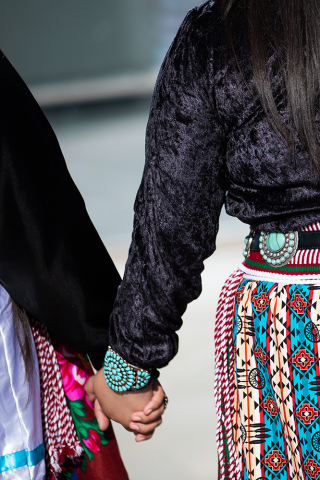
Terms to Know
NEH: The National Endowment for the Humanities is the country’s largest public funder of the humanities — it supports research, education, preservation, and public programs
NAGPRA: The Native American Graves Protection and Repatriation Act (NAGPRA) is a law requiring agencies receiving federal funding to repatriate ancestors, their funerary objects, sacred objects, and items of cultural patrimony to culturally- and/or geographically affiliated tribes.
Repatriate: restore something/someone to its original cultural origin or allegiance
Our goal has been to ensure we act as a conduit for these communities to tell their stories directly, rather than an outside authority, and to care for cultural items in accordance with the guidance provided by Tribal representatives. Indigenous communities are the authority on their own cultures – it’s our role to serve as a platform that amplifies their voices.
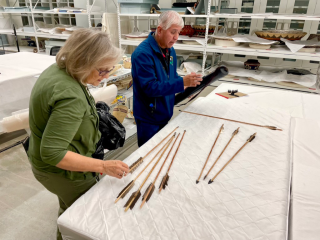
Flintknapper and traditional hunter Ira Coffey (Shoshone/Paiute), on the right, donating traditionally made arrows he manufactured; Collections Manager emeritus Glenna Nielsen-Grimm, Ph.D., on the left, learns from him about the appropriate storage and care methods. Alexandra Greenwald, Ph.D.
What Has the Native Voices Initiative Accomplished?
The Native Voices Initiative has aided in the reinterpretation of current ethnographic collections, reflecting those reinterpretations in our Native Voices exhibition, creating a digital repository to share and store data and oral histories, and fund both graduate research and extensive paid collaboration with tribal representatives. Here are a few highlights!
2022 Indigenous Art Market & Festival Performances
The NEH grant funded performances and programming for NHMU’s Indigenous Art Market & Festival in 2022. This included both traditional dance and musical performances which were featured in the weekend’s events to honor Indigenous traditions and educate Indigenous Art Market & Festival participants on cultures that might be outside of their scope of experience. This included performances by Soyer Toney (Northern Style Contemporary Jingle Dress Dancer), Julicia Brown (Navajo Basket Dancer), Jaelynn Brown (Navajo Basket Dancer), Shastee Holliday (Navajo Basket Dancer), Jacinda Begay (Navajo Hoop Dancer), Taylor Begay (Men's Contemporary Northern Traditional), Tyler Mose (Contemporary Native American Music), Don Mose Jr. (Contemporary Native American Music), Ryan Mose (Contemporary Native American Music).
1 of 8
Ethical Repatriation and Ethnographic Collections Expansion
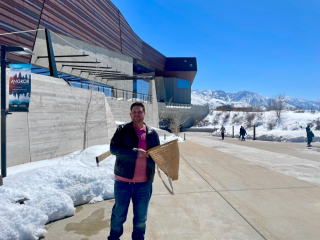
Bradley Parry (Vice Chairman of the Northwestern Band of the Shoshone Nation) donating a gathering basket made by his grandmother Mae Timbimboo Parry. Alexandra Greenwald, Ph.D.
Though NHMU’s long-established policies and commitment to ongoing consultation with Tribal communities ensures that our exhibitions and collections remain in compliance with requirements under the Native American Graves Protection and Repatriation Act, the Native Voices Initiative helped us communicate with Tribal communities about possible repatriation for cultural belongings that are not subject to NAGPRA. Through these discussions, we were able to nurture valued relationships and express our respect for the heritage, traditions, and rich cultural history of Utah’s Native peoples.
Though repatriation efforts are designed to return cultural belongings to their culture of origin, the relationships strengthened through the Native Voices Initiative led to NHMU experiencing an increase in our ethnography collection. Representatives from Tribal communities were happy that the objects in our collections aided research and provided opportunities for the public to learn about their cultures. This willingness to share their culture with others led to community members donating additional items to NHMU.
Consultation With Tribal Representatives
Too often, cultural items exhibited within museum spaces have been stripped down to their core descriptors, losing important context along the way. A rug is simply displayed and labeled, “Navajo Rug, artist unknown.” But the cultural objects displayed in these spaces are far more than decorative objects — they are the results of hundreds or thousands of years of cultural traditions, values, and belief systems that have been passed down through generations. They represent deep ecological knowledge and connections to family, community, and homelands.
A rug isn’t just a rug. It’s understanding how to care for your sheep (where to graze and water them through the seasons), and how to process their wool. It’s understanding how to gather and use natural plant and mineral dyes, engineer a loom, and create a design learned from watching a mother or grandmother work. It’s singing traditional weaving songs passed through generations. It’s using math to create a representation of your whole cosmology.
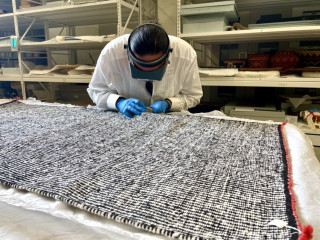
Weaver and textile expert Zefren Anderson (Navajo) examines a twilled Navajo rug in NHMU’s collections. Alexandra Greenwald, Ph.D.
Without centering these stories, traditions, and perspectives — without letting representatives of Indigenous communities lead the way — we risk losing sight of the significance of these objects. By stripping them down to a mere rug, we discredit the history and heritage that influenced the creation of that rug (or other item).
The NEH grant and Native Voices Initiative allowed Greenwald and her colleagues to bring in 24 paid consultants (across 14 different Tribal Nations represented in our Native Voices exhibition and from the greater region), leading to approximately 150 hours of interviews. These interviews were consultant-led, allowing them to share anything they wanted to discuss. They were intended to provide context and stories relating to the objects within our collection and exhibition spaces and aid staff in updating our standards of care to accurately reflect the preferences of Tribal experts.
Being involved one-on-one with the museum staff on the displays, signage, and collections gave us the opportunity to correct any misinformation they may have had. This is an important process that ensures Indigenous knowledge in the museum’s collections and exhibitions is correct in educating the public on the beauty of what the Natural History Museum of Utah has to offer.
These interviews also resulted in updates to the Native Voices exhibition, including two kiosks with video excerpts from these interviews, new artistic portraits, and quote overlays from members of each represented Tribal Nation. You can see these updates, and hear stories from our Indigenous consultants, now by visiting the Museum.
Importantly, the NEH grant supported fair compensation for consultants’ time. Anthropologists have a long history of assuming community members of the culture they are studying will share their knowledge for free, without fair compensation or the effort to build mutually beneficial long-term relationships. NHMU has long sought to honor the expertise and efforts of Native partners — and providing honoraria that reflects the time investment, travel, and deep cultural knowledge shared by Tribally-appointed consultants was a critical component of the grant funding.
1 of 5
Utah’s Indigenous Communities Lead the Way: Looking Ahead
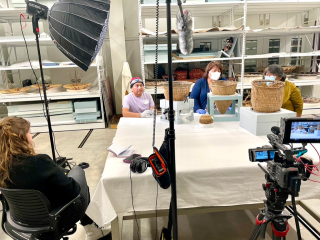
Discussing gathering baskets with representatives from the San Juan Southern Paiute (L-R former Chairman Richard Greymountain, Chairwoman Natalie Edgewater, former Chairwoman Louise Tallman). Graduate student Abby Baka (far left) takes notes. Alexandra Greenwald, Ph.D.
Over the last three years, the Native Voices Initiative has allowed NHMU to nurture existing relationships with members of Tribal communities and create new connections. These relationships are invaluable to our goals and mission as an institution, and we are actively seeking ways to continue strengthening these connections through thoughtful collaboration — including paid consultation by Tribally-appointed co-curators during the planning, designing, and presentation of a special exhibition on Indigenous baskets, which is planned for November 2026. As we move forward, we are eager to learn from, collaborate with, and share the Native Voices in Utah and the surrounding regions.
By centering Native stories, traditions, and perspectives shared with us by representatives from tribal communities whose cultures are represented in our collections and exhibits, we can reunite that traditional knowledge with the art and utilitarian items we care for, and act as a platform for these stories to be told to the general public.
1 of 17
